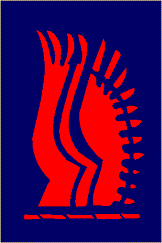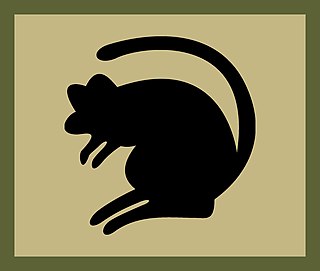
The Guards Armoured Division was an armoured division of the British Army during the Second World War. The division was created in the United Kingdom on 17 June 1941 during the Second World War from elements of the Guards units, the Grenadier Guards, Coldstream Guards, Scots Guards, Irish Guards, Welsh Guards, and the Household Cavalry.
The 20th Independent Infantry Brigade was an infantry brigade of the British Army, raised during the Second World War.

The 24th Infantry Brigade was an infantry brigade of the British Army from the First World War. It was reraised during the Second World War, as the 24th Infantry Brigade (Guards). During various designations, the brigade was active throughout the Cold War and existed until 1999, when it was merged with the 5 Airborne Brigade to become 16 Air Assault Brigade.

The 38th (Irish) Brigade, is a brigade formation of the British Army that served in the Second World War. It was composed of North Irish line infantry regiments and served with distinction in the Tunisian and Italian Campaigns. Following the end of the war, the brigade was disbanded, but was reformed in sixty years later in 2007 and remains the regional formation for Northern Ireland.

The 6th Armoured Division was an armoured division of the British Army, created in September 1940 during the Second World War and re-formed in May 1951 in the UK.
The 26th Armoured Brigade was part of the British Army during the Second World War.

The 9th Armoured Division was an armoured division of the British Army, raised during the Second World War. It never saw active service during the war as a complete division.
The 28th Armoured Brigade was an armoured brigade formation of the British Army, raised during the Second World War.

4th Light Brigade Combat Team, previously known as 4th Infantry Brigade and Headquarters North East, and before that as 4th Mechanized Brigade and before that 4th Armoured Brigade is a brigade formation of the British Army, currently based in Catterick, North Yorkshire as part of 1st Division. The brigade, now known as the 'Black Rats', was formed in 1939 and fought in the Second World War in the Western Desert Campaign in North Africa. The Black Rats were subsequently involved in the invasion of Sicily and fighting in Italy before taking part in the Battle of Normandy and the advance through Belgium, Holland and into Germany.

The 1st Cavalry Division was a regular Division of the British Army during the First World War where it fought on the Western Front. During the Second World War it was a first line formation, formed from Yeomanry Regiments. It fought in the Middle East before being converted to the 10th Armoured Division.

The 10th Armoured Division was an armoured formation of division-size of the British Army, raised during the Second World War and was active from 1941–1944 and after the war from 1956–1957. It was formed from the 1st Cavalry Division, a 1st Line Yeomanry unit of the Territorial Army (TA) which had previously been serving in Palestine. The division was converted from cavalry to armour and redesignated from 1 August 1941.

The 11th Security Force Assistance Brigade is a brigade of the British Army which is intended to train and assist foreign forces. In 2021, under the Future Army changes, the brigade was redesignated, formerly being the 11th Infantry Brigade & HQ South East. Prior to the Army 2020 changes in 2013, the brigade was temporarily activated for deployment to Afghanistan. Originally formed in the Second Boer War, the brigade was engaged during both World Wars.

The 29th Infantry Brigade was an infantry brigade unit of the British Army. It was originally raised in 1914 and saw service during the First and Second World Wars and the Korean War.

The King's Own Royal Regiment (Lancaster) was a line infantry regiment of the British Army. It served under various titles and fought in many wars and conflicts, including both the First and the Second World Wars, from 1680 to 1959. In 1959, the regiment was amalgamated with the Border Regiment to form the King's Own Royal Border Regiment.

The Border Regiment was a line infantry regiment of the British Army, which was formed in 1881 under the Childers Reforms by the amalgamation of the 34th (Cumberland) Regiment of Foot and the 55th (Westmorland) Regiment of Foot.

The Loyal Regiment (North Lancashire) (until 1921 known as the Loyal North Lancashire Regiment) was a line infantry regiment of the British Army that was in existence from 1881 to 1970. In 1970, the regiment was amalgamated with the Lancashire Regiment to form the Queen's Lancashire Regiment which was, in 2006, amalgamated with the King's Own Royal Border Regiment and the King's Regiment (Manchester and Liverpool) to form the Duke of Lancaster Regiment (King's, Lancashire and Border).

The 6th Guards Tank Brigade was an armoured brigade of the British Army during the Second World War formed from the Foot Guards in 1941 as the 6th Guards Armoured Brigade when the United Kingdom was under the threat of invasion and more armoured formations were required.

The Grenadier Guards is the most senior infantry regiment of the British Army, being at the top of the Infantry Order of Precedence. It can trace its lineage back to 1656 when Lord Wentworth's Regiment was raised in Bruges to protect the exiled Charles II. In 1665, this regiment was combined with John Russell's Regiment of Guards to form the current regiment, known as the 1st Regiment of Foot Guards. Since then, the regiment has filled both a ceremonial and protective role as well as an operational one. In 1900, the regiment provided a cadre of personnel to form the Irish Guards; while later, in 1915 it also provided the basis of the Welsh Guards upon their formation.

The Guards Division was an infantry division of the British Army that was formed in the Great War in France in 1915 from battalions of the Guards regiments from the Regular Army. The division served on the Western Front for the duration of the First World War. The division's insignia was the "All Seeing Eye".
The 21st Indian Infantry Brigade was an infantry brigade formation of the Indian Army during World War II.

















